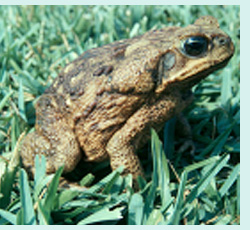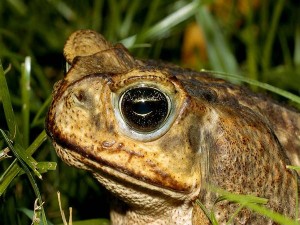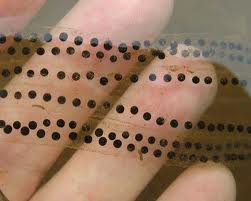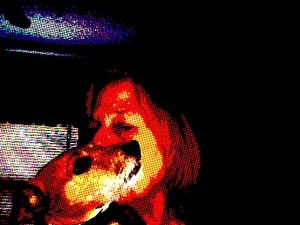Watch out . . . It’s the season of the dreaded BUFO TOAD!
By Barbara Phillippi
If you have a dog, and have lived in Florida for any length of time, you’ve heard about the “Bufo Toad,” Bufo marinus, Linnaeus, 1758.
Common names: Marine Toad, Giant Toad, Cane Toad

Bufonidae is the family of the true toads, members of the order Anura (frogs and toads). It is the only family of anoraks in which all members are known as “toads” The bufonids now comprise more than 35 genera, Bufo being the most widespread and well known. The toads are large, many around six inches long; stocky amphibians with dry, warty skin. And for your dog, they’re dangerous creatures, indeed; the venomous glands on a toad’s back have caused many a pet owner to head for the emergency vet on a warm and steamy summer night.
Known in other parts of the world as the “Cane Toad,” The Bufo Toad is native to a few areas in the southern United States, Central America, and tropical South America. Its venom is a mix of toxins present throughout their bodies and is secreted as a milky liquid from the parotoid glands located over the toad’s shoulders. The poison primarily affects the functioning of the heart. A curious dog that is not confined or restrained will grab at a Bufo with its mouth, and pay dearly for the experience.
Envenomation is painful, but rarely deadly to humans, although some people have died from eating cane toads and even their eggs. The venom is a neurotoxin, which interacts with the mucus membranes, and does not need to be swallowed to poison your dog.
Gracie (my Jack Russell Terrier) and I have recently moved, and it’s a wonderful place for long, relaxing walks in the moist cool of the evening. But I must be vigilant! Such excursions are rife with danger for my beloved companion, as under every streetlight is a gang of these giant toads who hide in dark, damp places in the daytime, and emerge to dine after dark on insects attracted by the lights. They will also eat pet food left outside, and forage through garbage.
Our new digs back up to a nature preserve, and maybe we have so many of the darned things in our yard because the wetlands behind me are just what these critters need to reproduce and thrive. Gracie has always scrambled furiously at the end of the leash for anything small that moves. And she can sense presence of a toad or other creature in the shadows, unseen by me. Eggs are laid in strips, and can be hidden in the grasses on the water’s edge.

I spoke with Debbie, the office manager, at Palms Wes tAnima lHospital. She says, “We’ve already had a few poisonings this year, but we’ve saved them all.”
Dr Richard Kelleher, the new vet at the practice, can’t say if the numbers of Bufo poisoning have increased this year, but he practiced 12 years in Boynton Beach, and is very familiar with the problem here in South Florida.
“The signs of Bufo poisoning are pretty obvious. Oral contact with the toad causes frothing from the mouth, bright red gums, and seizures, which will happen almost immediately as the heartbeat and respiration slow down,” he says. The prognosis depends on the duration and severity of the exposure, and how long it takes to get to the vet. “The size of the toad doesn’t seem to matter,” he says,” but the results “are worse for small dogs.”
What should a dog owner do if his dog presents these symptoms? “Immediately rinse the dog’s mouth with as much water as you can, not to make it swallow, we don’t want it to ingest the poison, but to remove as much of the toxicity as possible,. And have someone call the vet right away.” After the animal arrives at the clinic, “it is given IV fluids with sedation for the seizure activity and symptomatic support, and monitored closely.” Observation time can vary from 8 – 24 hours.
My friend Donna has had her battles with the Bufos. “None of my dogs ever died from the terrible frogs but came close. I spent tons of money at the vet’s office and he always pulled them through. Last April, my deaf JRT just made it to the vet’s office in time. I drove like a maniac, running red lights in the pouring rain. She had to stay at Dr. Simmons office for almost a week. I had a fenced in back yard with a pool and grassy areas. I had a contractor pour concrete and take out the grass, to deter the frogs from coming into the yard. Those toads are so toxic, all a creature has to do is lick it and they will be affected. They are terrible creatures.”
“I went online to ask how to kill, eradicate or otherwise do away with these frogs, and I got attacked by frog/toad friends. Calling my dogs stupid if they went back for more… But try telling a JRT (Jack Russell Terrier) not to chase something that hops into their territory. I finally moved from South Florida to the Ocala area. And, thank goodness, I have not seen any here in the 7 years of living here.”
A suggestion for folks with dog runs or dog yards: place plexiglass panels against the entire inside of the barrier fence. There is an anecdotal report that mothballs around the perimeter will keep the critters away from your premises. For the rest of us, especially those whose dogs have a strong hunt/kill drive: keep your dog on a short leash at all times during the warm season. Never let your dog roam.
I asked Dr Kelleher about cats poisoned by Bufo venom. He thought for several moments. “Hmmm, I’ve never seen one, come to think of it. No, not one.” Is that because cats are smarter than dogs, and know better than get into a dust up with a Bufo?” I asked, half in jest. “Well,” he laughed, then said, “I’m a cat person, so I suppose that could be true.”
The Smithsonian Marine Station at Fort Pierce, Florida, offers the curious reader a page about the history of the local Bufo Toad, describing intentional releases at Canal Point and in Palm BeachCounty, and other Florida locations. Here’s a great link:
http://www.sms.si.edu/irlspec/bufo_marinus.htm
And here’s what happened when Australia imported a small number to help eradicate the sugar cane beetle…
The much maligned venomous cane toads earned their bad reputation shortly after being released into the Australian ecology in 1935, with the hope that they would control the destructive cane beetle population. They turned out to be failures at controlling beetles, but remarkably successful at reproducing and spreading themselves.
About 3,000 cane toads were released in the sugarcane plantations of north Queensland in 1935. They now number well into the millions, and their still expanding range covers thousands of square miles in northeastern Australia. They are considered pests, and government eradication efforts include asking residents to help collect and dispose of them.

Their numbers are manageable in their natural range, but they have thrived in Australia because there are few natural predators, they breed easily, and they have abundant food, including pet food, which they steal from feeding bowls left outside of homes. Their effects on Australia’s ecology include the depletion of native species that die eating cane toads; the poisoning of pets and humans; depletion of native fauna preyed on by cane toads; and reduced prey populations for native insectivores, such as skinks.
So, please, be alert when you walk your dog, keep it safe from contact with a Bufo at all cost. Be vigilant, and enjoy a safe summer!
“In a perfect world, every home would have a dog, and every dog would have a home.”
***
Over a lifetime, Barbara Phillippi has had mostly “normal” dogs – a few German Shepherds and a bunch of wonderful “mutts,” each with its own wonderful, quirky, qualities. For many years, she taught 4-H dog obedience courses, under the authorization of Cornell University’s Cooperative Extension Services. That terrific program teaches the basics of dog behavior, of every breed, to young dog owners. Today she lives in Wellington with three Jack Russell Terriers – Woody, Gracie, and Buck. “These guys showed me a learning curve that I never knew existed!”


